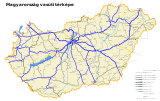Rail transport in Hungary
| Rail network in Hungary | |||||
|---|---|---|---|---|---|
 | |||||
| Operation | |||||
| National railway | Magyar Államvasutak (MÁV) | ||||
| Statistics | |||||
| Ridership | 110 million (2017)[1] | ||||
| System length | |||||
| Total | 8,057 kilometres (5,006 mi) | ||||
| Double track | 1,335 kilometres (830 mi) | ||||
| Electrified | 3,060 kilometres (1,900 mi) | ||||
| High-speed | 0 kilometres (0 mi) | ||||
| Track gauge | |||||
| Main | 1,435 mm (4 ft 8+1⁄2 in) | ||||
| Features | |||||
| No. tunnels | 21 | ||||
| Longest tunnel | Kopár-hágó tunnel 780 metres (2,560 ft) | ||||
| Longest bridge | Nagyrákos viadukt 1,399 metres (4,590 ft) | ||||
| |||||
Rail transport in Hungary is mainly owned by the national rail company MÁV, with a significant portion of the network owned and operated by GySEV.
The railway network of Hungary consists of 7,893 km (4,904 mi), its gauge is 1,435 mm (4 ft 8+1⁄2 in) standard gauge and 3,060 km (1,900 mi) are electrified.
Hungary is a member of the International Union of Railways (UIC). The UIC country code for Hungary is 55.
Statistics
[edit]- Railway lines total: 7,606 km (4,726 mi)
- Standard gauge: 7,394 km (4,594 mi)
- Broad gauge: 36 km (22 mi) of 1,520 mm (4 ft 11+27⁄32 in)
- Narrow gauge: 176 km (109 mi)
Note: The standard and broad gauge railways are operated by the State Railways and also the following narrow gauge railways: Nyíregyháza–Balsai Tisza part/Dombrád; Balatonfenyves–Somogyszentpál; Kecskemét–Kiskunmajsa/Kiskőrös and the Children's Railway in Budapest. All the other narrow gauge railways are run by State Forest companies or local non-profit organisations. See also Narrow gauge railways in Hungary.
Financial performance and corporate statistics
[edit]- Revenue = 372,549 million Ft (2014)[2]
- Net income = 22,851 million Ft (2014)[2]
- Number of employees = 38,456 (2009)
- Owner = Hungarian state (100% state ownership)
Rail links to adjacent countries
[edit]Same gauge:
 Austria — voltage change 25 kV AC / 15 kV AC
Austria — voltage change 25 kV AC / 15 kV AC Croatia — same voltage 25 kV AC
Croatia — same voltage 25 kV AC Romania — same voltage 25 kV AC
Romania — same voltage 25 kV AC Serbia — same voltage 25 kV AC
Serbia — same voltage 25 kV AC Slovakia — same voltage 25 kV AC (west) and 3 kV DC (east)
Slovakia — same voltage 25 kV AC (west) and 3 kV DC (east) Slovenia — voltage change 25 kV AC / 3 kV DC
Slovenia — voltage change 25 kV AC / 3 kV DC
Break-of-gauge (1,520 mm (4 ft 11+27⁄32 in):
 Ukraine — no electrified rail link
Ukraine — no electrified rail link
Modern and historical railway maps
[edit]-
1898 railway map of Austria-Hungary
-
1912 railway map of Kingdom of Hungary
-
Electrified railways in Hungary
Train categories
[edit]Urban rail
[edit]Commuter
[edit]The largest agglomeration of Hungary has a suburban rail system:
| City | System | Operator | Electrification | Conductor system | Gauge | Bidirectional traffic |
|---|---|---|---|---|---|---|
| Budapest | BHÉV | MÁV–HÉV | 1000 V DC | Overhead line | 1,435 mm (4 ft 8+1⁄2 in) standard gauge | Right-hand traffic (with the exception of lines H8 and H9) |
Metro
[edit]The largest city in Hungary has a Metro system:
| City | System | Electrification | Conductor system | Gauge | Bidirectional traffic | Opened |
|---|---|---|---|---|---|---|
| Budapest | Budapest Metro | 550 V DC (M1) 750 V DC (M4) 825 V DC (M2, M3) |
Overhead line (M1) Third rail (M2, M3, M4) |
1,435 mm (4 ft 8+1⁄2 in) standard gauge | Right-hand traffic | 3 May 1896 |
Tram
[edit]There are also tram systems in the following cities:
| City | System | Electrification | Operator | Gauge | Bidirectional traffic | Opened |
|---|---|---|---|---|---|---|
| Budapest | Budapest Tram | 600 V DC | BKV | 1,435 mm (4 ft 8+1⁄2 in) standard gauge | Right-hand traffic | 30 July 1866 |
| Debrecen | Debrecen Tram | 600 V DC | DKV | 1,435 mm (4 ft 8+1⁄2 in) standard gauge | Right-hand traffic | 16 March 1911 |
| Miskolc | Miskolc Tram | 600 V DC | MVK | 1,435 mm (4 ft 8+1⁄2 in) standard gauge | Right-hand traffic | 10 July 1897 |
| Szeged | Szeged Tram | 600 V DC | SZKT | 1,435 mm (4 ft 8+1⁄2 in) standard gauge | Right-hand traffic | 1 July 1884 |
| Hódmezővásárhely | Szeged-Hódmezővásárhely Tram-train | 600 V DC | MÁV-Start | 1,435 mm (4 ft 8+1⁄2 in) standard gauge | Right-hand traffic | 29 November 2021 |
See also
[edit]- List of railway lines in Hungary
- Transport in Hungary
- Hungarian State Railways
- List of Hungarian locomotives
References
[edit]- ^ "Railway Statistics – 2017 Synopsis" (PDF). International Union of Railways, IUC. 2017. Archived from the original (PDF) on 7 April 2019. Retrieved 11 June 2019.
- ^ a b "Consolidated Annual Report 2014" (PDF) (in Hungarian). Budapest: MÁV Magyar Államvasutak Zrt. 4 June 2015. Retrieved 30 July 2015.




